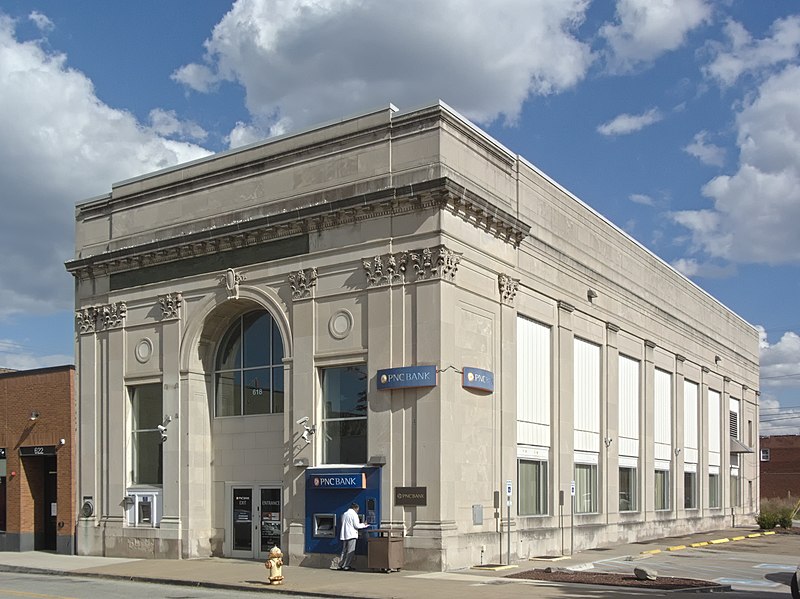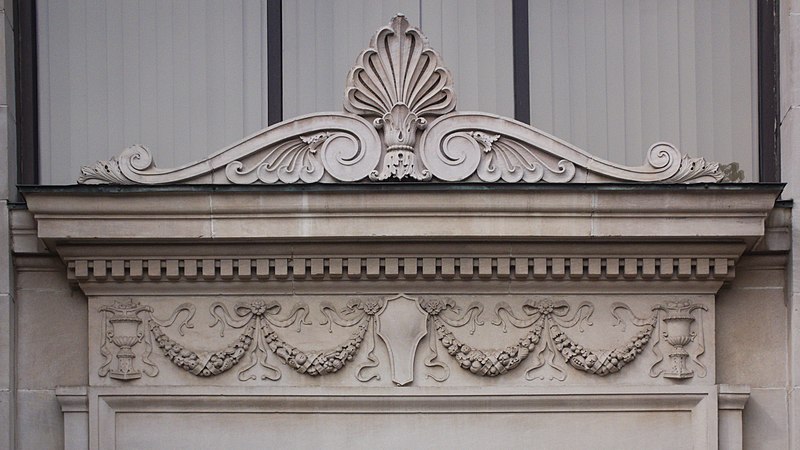
Probably built in the 1890s, this grand house on Wightman Street has its very Victorian trim picked out in cheerful colors. Note the thoroughness of the decoration: even the dormers are given little pilasters with Ionic capitals.




Here is another small bank that gets the architectural message exactly right, as we said a few days ago about the Carnegie National Bank. How could your money not be safe in a bank that looks like this? Imagine, too, how bright and cheerful the banking hall must have been before those tall windows along the side were filled in.

Winged chimeras guard the cartouche at the top of the great front arch.


Addendum: The bank was built in about 1924; the architects were Simons, Britton & English.1

Architecture is a kind of message that we instinctively read. When we see a bank that looks like this, we think without even articulating the thought, “That bank is stable and respectable.” The richness of the materials tells us that the bank has plenty of money; the traditional classical design tells us that it is not some fly-by-night institution that somehow swindled its way into a few bucks and will be gone as soon as its trendy design is passé. This bank on Main Street in the borough of Carnegie hits all the right notes with perfect pitch. We have forgotten how to send these architectural messages, but curiously enough we have not forgotten how to read them.
Addendum: The architect was Greensburg-based Paul A. Bartholomew; the bank was built in 1926.



This building is an epitome of the history of the South Side. The first wave of immigrants after the original English and Scotch-Irish settlers was the Germans. There was a Turnhalle, a German athletic club, on this site by 1872, and probably well before; it was across the street from a German Evangelical church. That original Birmingham Turnverein was a frame building, but this splendid brick structure was put up some time a little before 1910. (If you enlarge the picture, you can see a pair of “BTV” monograms on the façade near the entrance.) Then came the influx of East Europeans, and many of the Germans moved out. This became a Lithuanian Hall; the German church across the street was demolished and replaced with a Ruthenian Catholic church. In the twenty-first century, we have all become antisocial, and clubs and churches have died; the building has been turned into apartments, as many similar buildings have been.

The McNally Building on Penn Avenue was built in 1896. It is a good example of the kind of tall, narrow building that grew up in the early days of the elevator. But of course the most important thing about this picture is that it allows old Pa Pitt to indulge in his habit of photographing buses coming toward you.
Addendum: The architect was Thomas D. Evans, who also designed the Springfield and Morse schools. Source: The Inland Architect and News Record, March 1895.
Architect T. D. Evans has plans completed for the McNally building, an eight-story warehouse, to be erected on Penn avenue, stone and brick.


Father Pitt picked up a Fujifilm HS10 camera very cheaply, and here is a demonstration of its long range. The picture above and the picture below were taken standing in the same spot: the steps of the Mellon Institute across Fifth Avenue. The picture above is not a composite: the lens is wide enough for the whole building. (Of course the perspective has been adjusted, because old Pa Pitt wouldn’t let a picture go without doing that.)

A scallop-shell ornament over one of the windows in the upper floors. The long lens makes it easy to pick out interesting details, and the details on Webster Hall, designed by Henry Hornbostel, are worth picking out. It’s a kind of Art Deco Renaissance palace, built as luxury apartments, but soon changed into a hotel, and then back to luxury apartments again.





We saw the front as it looked 22 years ago (and as it looks today, because nothing has changed except the plantings). This is the Bigelow Boulevard side the way it looked the day before yesterday, as seen from Lytton Avenue a block away. Supposedly this was the side that architect Henry Hornbostel had been forced to agree to make the front, but then he built the thing his way anyway, with a long vista down to Fifth Avenue.
Old-timers will remember the parking lot in the foreground as Syria Mosque.